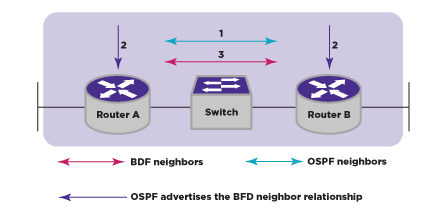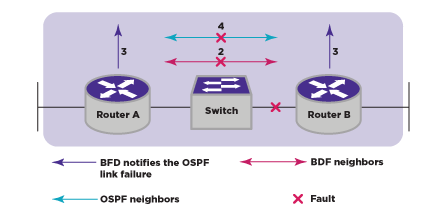BFD for OSPFv3

Establishing a BFD Session for OSPFv3 Neighbor
- OSPFv3 discovers a neighbor.
- If BFD for OSPFv3 is configured, OSPFv3 on both routers sends a request to the local BFD server to initiate a BFD neighbor session with the OSPFv3 neighbor router.
- The BFD neighbor session with the OSPFv3 neighbor router is established on both sides if BFD session limit is not reached.
If the BFD session limit is reached, the OSPFv3 neighbor will be marked as BFD session failed if synchronous request is used, or pending if asynchronous request is used, and the BFD server will send an asynchronous notification when the session registration passes later. (The asynchronous request is not available until the BFD client session create API is enhanced.)
Eliminating the OSPFv3 Neighbor Relationship by BFD Fault Detection
- A failure occurs in the network.
- The BFD neighbor session with the OSPFv3 neighbor router is removed because the BFD timer expired.
- On both Router A and Router B, BFD notifies the local OSPFv3 process that the BFD neighbor is DOWN.
- The local OSPFv3 process tears down the OSPFv3 neighbor relationship by marking neighbor state DOWN. (If an alternative path is available, the routers will immediately start converging on it.)

OSPFv3 will request the BFD server to delete the BFD session for OSPFv3 neighbor moved to DOWN state. When the link failure is later resolved, OSPFv3 needs to register the re-discovered neighbor to BFD again to initiate BFD session creation.
Removing BFD Protection for OSPFv3
- BFD protection is removed from OSPFv3 interface on Router A, OSPFv3 process requests BFD server to delete all BFD sessions for neighbors learned on that interface.
- BFD server will stop sending session status update to local OSPFv3 process on Router A.
- Before actually deleting any sessions, BFD server on Router A will first notify Router B to mark those session status as "Admin Down," which will cause Router B to stop using BFD protection for those OSPFv3 neighbors.
- When BFD protection is removed from OSPFv3 interface on Router B, BFD sessions can be deleted immediately since they are already in "Admin Down" state.
When BFD for OSPFv3 is configured on broadcast interface, the default behavior is to register only OSPFv3 neighbors in FULL state with the BFD server. Separate BFD sessions are created for each neighbor learned on the same interface. If multiple clients ask for the same neighbor on the same interface, then single BFD sessions are established between the peers.
OSPFv3 Neighbor State Determination
- If BFD is enabled on the interface, and
- If BFD for OSPFv3 is configured on the OSPFv3 interface, and
- If a BFD session has been established to the neighbor, and
- If the BFD session has passed the INIT_COMPLETE state then:
- The OSPFv3 neighbor relationship will remain as FULL if the operational state of the BFD session is "UP" and the operational state of the associated VLAN interface is UP.
- The OSPFv3 neighbor relationship will be considered as DOWN if the operational state of the BFD session is DOWN or the operational state of the associated VLAN interface is DOWN.
In all other cases, the BFD session state is not considered as part of the reported OSPFv3 neighbor state, and the OSPFv3 neighbor state reverts to the operational state of the OSPFv3 interface only. When the BFD session is in ADMIN_DOWN state, OSPFv3 ignores BFD events and OSPFv3 neighbor adjacency is not be affected by the BFD session state change.

